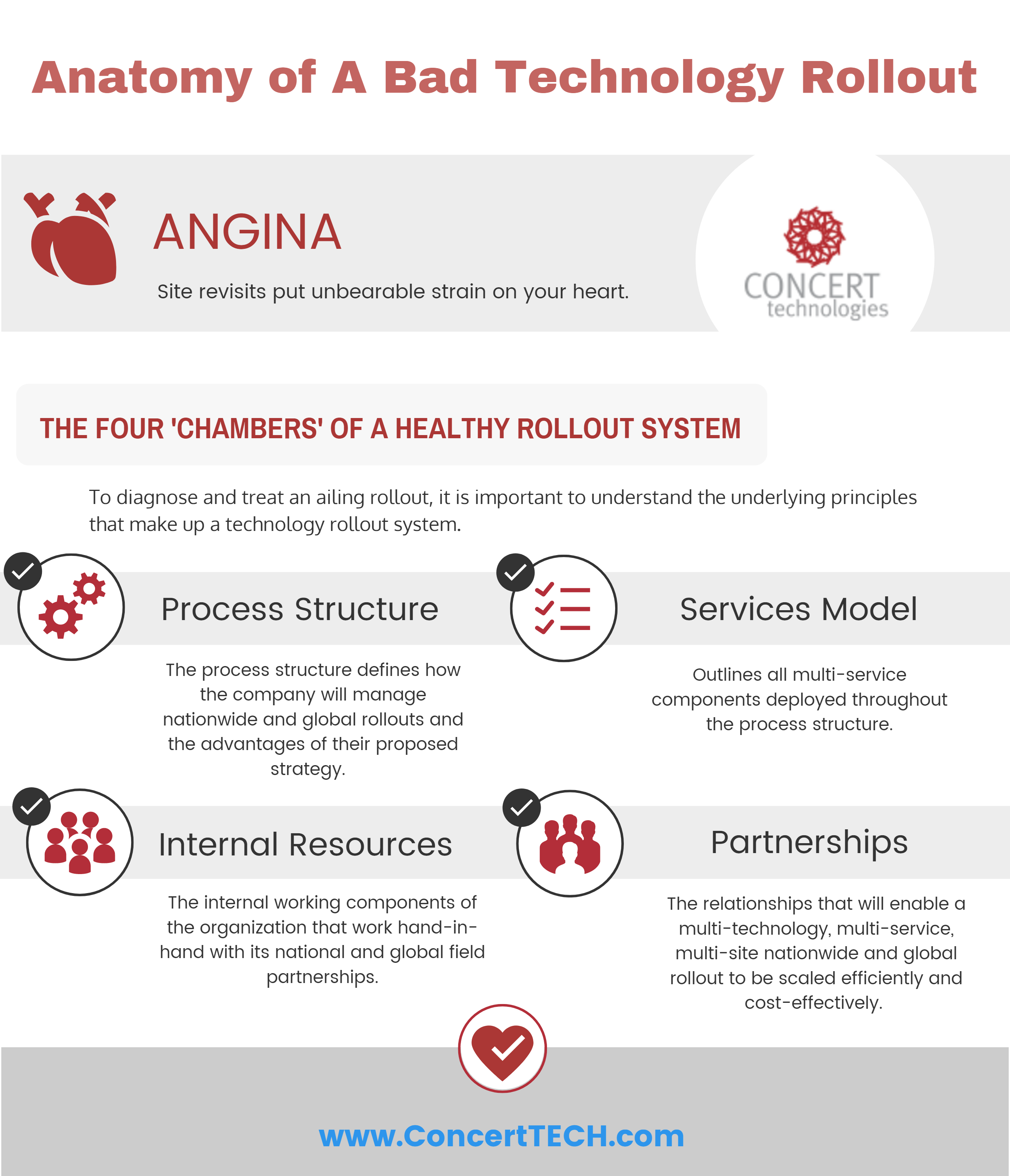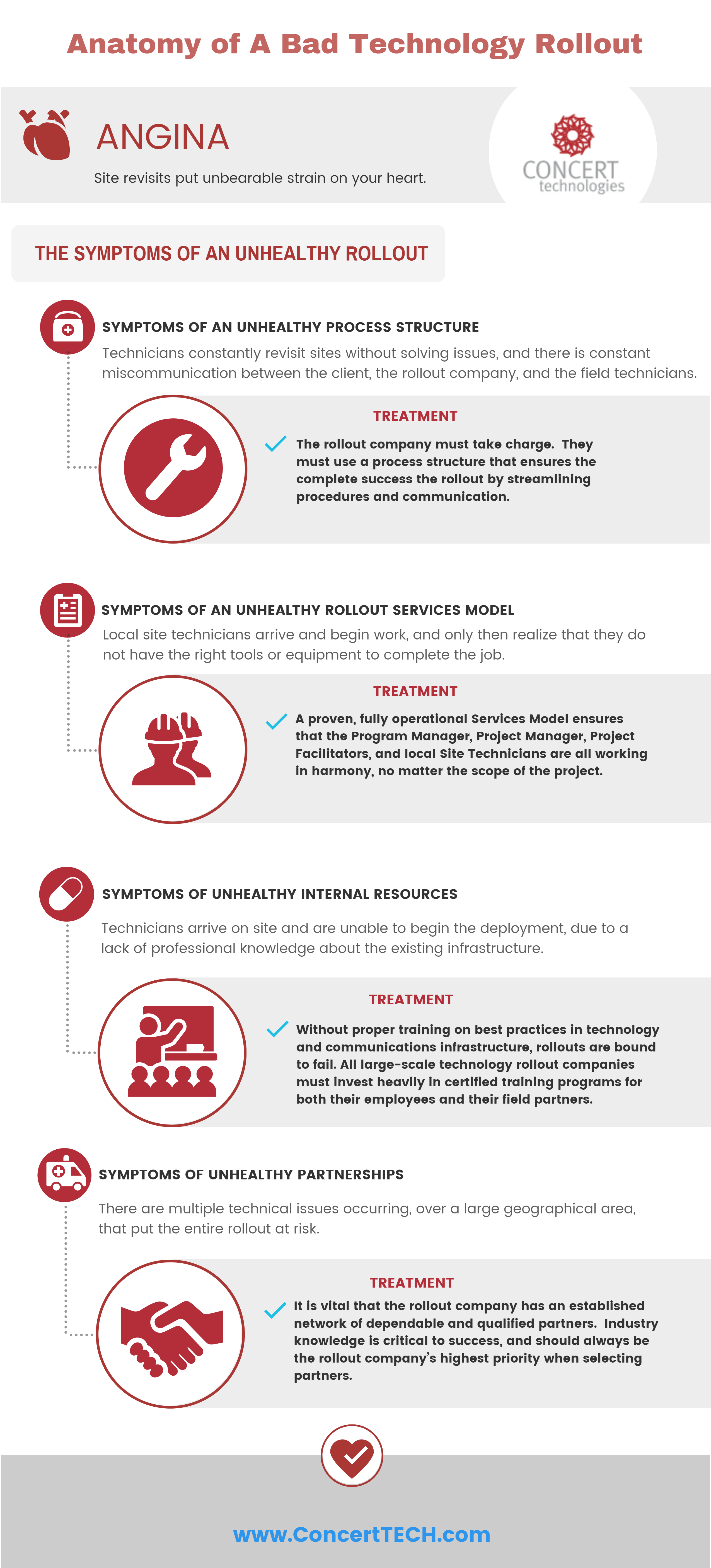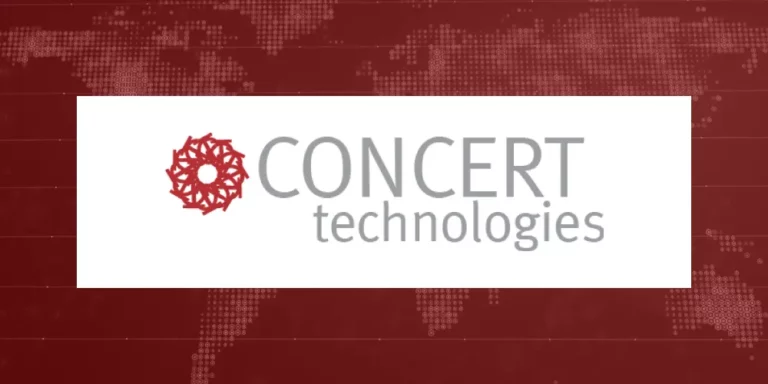A multi-site technology rollout consists of a detailed solution that requires technology services delivered by dutifully managed onsite field technicians. It is a large and complex project that is dependent on the processes, services, resources, and relationships of the technology rollout company, and its ultimate success hinges on the ability of that company to effectively deploy the solution.
Just as each chamber of the heart plays a vital role in the circulation of blood throughout the human body, the four parts of the rollout company methodology work together to pump the lifeblood of a rollout system.
If one of these parts is not functioning properly, then there will inevitably be setbacks throughout the deployment phase. These setbacks can trigger costly site revisits and place a serious strain on the timeline and functionality of the proposed solution.
In other words, when the rollout system is sick, this underlying health issue will manifest itself as painful bouts of symptom flare-ups, or heartaches!
To diagnose and treat an ailing rollout, it is important to understand the underlying principles that compose a complete technology rollout solution. Healthy, fully-developed and unified rollout systems and methodologies prioritize efficiency and provide a detailed outline of each component in the system.

Process Structure
The process structure defines how the rollout company will manage nationwide and global rollouts. The structure that utilizes direct partnerships and emphasizes the direct management of local field technicians is known as Centralized Single-Tier. This structure ensures the system is healthy throughout the rollout life-cycle and provides a solution to the following issues:
• The responsibilities of the technology rollout company
• Process of minimizing project costs
• Risk management and quality of service
• Technician redundancy to ensure timely project completion
• Timely and accurate communication
• Project tracking and accountability
• Site Liability Issues
• Quality of the local technician
Case Study of an Unhealthy Process Structure
SYMPTOMS:
Technicians constantly visit sites without fully addressing the issue. There is continual miscommunication between the client, the rollout company, and the local field technicians, creating frustration and heartache at every level.
DIAGNOSIS:
The process structure of the of rollout company is not Centralized Single-Tier. This creates inaccurate communications at each tier (rollout company, each subcontracted technician, and the client), as well as between those tiers.
TREATMENT:
Efficient project communication is a crucial element to the success of any rollout process structure. If issues continue to negatively impact the proposed timeline, then re-evaluation of the client-company partnership is advisable. The rollout company must take charge of ensuring the complete success of each part of their process structure and at every level throughout the deployment.
Rollout Services Model
The Services Model outlines all multi-service components deployed throughout the process structure. Effective Services Models are proven prototypes that enable orchestrated, multi-site, multi-technology rollout services for all types and sizes of projects. They include detailed guides to the successful planning, management, and implementation of the necessary services and processes for the entire project. They should include complete summaries of the following model components:
• Project Management
• Circuits
• Equipment & Technology
• Cabling
• Site Surveys & Estimates
• Logistics & Configuration
• Maintenance
• Billing
• Solution Support
Case Study of an Unhealthy Rollout Services Model
SYMPTOM:
The local site technicians arrive, begin work and realize that they do not have the right tools or equipment to complete the job. They promise that they will return as soon and possible, but leave the job incomplete and do not provide a timetable for a solution.
DIAGNOSIS:
The Program Manager has not performed his due diligence in preparing the team for the job. The Program Manager oversees all programs and Project Managers, as well as providing quality assurance. If the Project Facilitator, who leads day-to-day operations and delivery of rollout services, and the team of local technicians is not prepared, then it signifies that the Program Manager is following an inadequate Rollout Services Model.
TREATMENT:
A proven, fully operational Rollout Services Model ensures that the members of the project management team – Program Manager, Project Manager, and Project Facilitators – all work in harmony, no matter the scope of the project. If serious logistics issues are arising, it indicates that the Rollout Services Model needs to be optimized. Spend the necessary time to address the issues of concern. In this case, it is advisable to spend more time optimizing Site Surveys & Estimates, and Logistics & Configuration before any new projects are initiated.


Internal Resources
The internal resources of a rollout company, are the internal working components of the organization that work hand-in-hand with its national and global field partnerships. The Internal Resources are the backbone of the company, and provide the necessary tools to implement a successful Rollout Services Model. They deliver multiple channels of communication to customers. They include:
• Internal Operations
• Network Infrastructure
• Software Applications
• Training
• Company Culture
Case Study of Unhealthy Internal Resources
SYMPTOM:
Technicians arrive on site and are unable to begin deployment, due to a lack of professional knowledge about the existing infrastructure. They leave the site after a short amount of time and don’t give any explanation as to why they cannot complete the job.
DIAGNOSIS:
The site technicians and PMs did not receive the necessary training from the rollout company. This lack of professional knowledge stems from inadequate training programs. It is the company’s responsibility to give all their employees the proper training for every aspect of their job.
TREATMENT:
Without proper training on best practices in technology and communications infrastructure, a rollout is bound to fail. All large-scale technology rollout companies must invest heavily in certified training programs for their employees and partners.
Partnerships
The management of suitable partnerships for every type of technology deployment is the key to a successful technology rollout solution. It is these relationships that enable a multi-technology, multi-service, multi-site nationwide and global rollout to scale efficiently and cost-effectively. In a successful technology rollout system, effective partnership management prioritizes:
• Proven Expertise
• Proven Deployment Volume
• Industry Knowledge
• Financial Strength
• Technician Redundancy
• Local Resource Distribution – Nationwide & Globally
• Certification & Professionalism
Case Study of Unhealthy Partnerships
SYMPTOM:
Most jobs within a nationwide deployment proceed on-time and on-schedule, however there are multiple issues occurring over a large geographical area that put the rollout at risk.
DIAGNOSIS:
After review, it becomes evident that the subcontracted technicians are new partners and don’t have the experience to complete the job. If these types of issues occur on an ongoing basis, then the rollout company does not have the necessary partnerships to complete large scale deployments.
TREATMENT:
It is vital that the rollout company has an established network of dependable and qualified partners. Proper vetting procedures need to be followed when new partnerships are initiated. Industry knowledge is indispensable and should be of a rollout company’s highest priority when selecting partners.
The Doctor’s Orders.
If you are at risk of deploying a poorly conceived rollout, then you are also at risk of falling victim to long lasting infrastructure issues. Prevent bad rollouts before serious issues arise by ensuring the right team is in the place from the start. Set guidelines and outline the project requirements to ensure a successful rollout.
The bottom line is that preventive care is far less costly than restorative treatment. A qualified rollout company provides a fully developed and unified rollout solution that clearly defines their responsibility. The solution includes a detailed guide on how the rollout is executed, and the key benefits to the client.
While chronic chest pains may not signify a potential heart attack, it is always better to be safe than sorry. The same is true of potentially catastrophic rollout pains. At the first sign of problems during a rollout, take the time to seek out an EXPERIENCED partner and ask for their advice.
Before You Initiate Your Next Rollout, Be Sure To Download The FULL ‘Anatomy Of a Bad Technology Rollout: Angina’ PDF.




